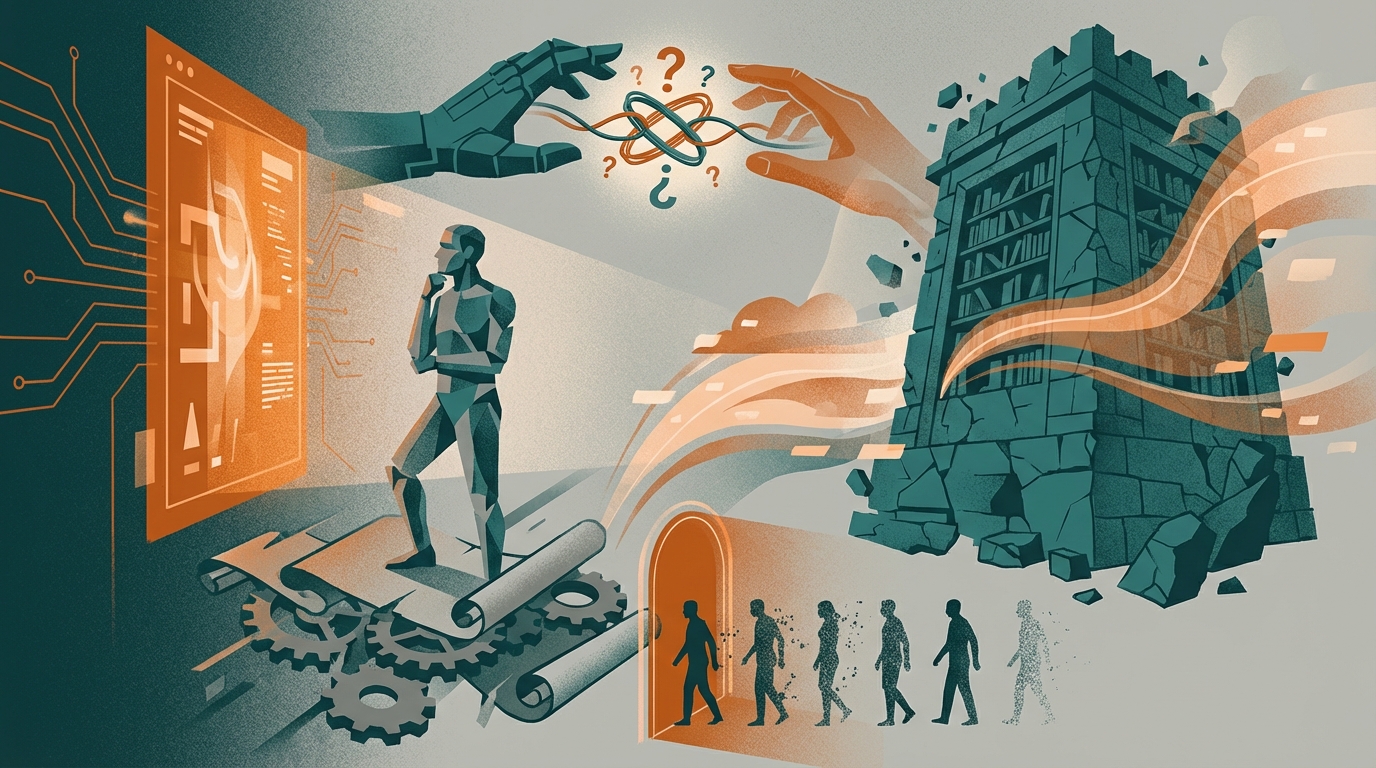THIS WEEK'S ANALYSIS
Universities Deploy Detection Tools While Teaching Prompts: Academia's Schizophrenic AI Response
Across institutions, a striking paradox emerges: universities simultaneously ban AI for academic integrity while mandating its integration for 21st-century skills. This cognitive dissonance reveals deeper tensions—assessment systems designed for industrial-era education cannot distinguish between AI-enhanced learning and plagiarism, forcing institutions into reactive policies that contradict their pedagogical goals. The rush to implement AI literacy frameworks occurs alongside sparse evidence of effectiveness, while equity concerns mount as AI amplifies existing educational inequalities. Perhaps most tellingly, the scramble to preserve traditional evaluation methods exposes what these assessments have always been: measures of compliance rather than authentic learning, now rendered obsolete by tools that can simulate their outputs perfectly.
Navigate through editorial illustrations synthesizing this week's critical findings. Each image represents a systemic pattern, contradiction, or gap identified in the analysis.
PERSPECTIVES

Through McLuhan's Lens
When universities scrambled to deploy AI detection tools against ChatGPT, they missed what Marshall McLuhan would have seen instantly: the real crisis isn't cheating—it's that AI has exposed what acad...
Read Column →
Through Toffler's Lens
When a 50-year-old technology crashes into modern AI, the resulting chaos reveals more than a cheating crisis—it exposes the death throes of industrial-era education. Why are universities simultaneous...
Read Column →
Through Asimov's Lens
A literature professor discovers her struggling students have transformed into sophisticated writers in just one semester—not through cheating, but through AI conversations that challenged their think...
Read Column →THIS WEEK'S PODCASTSYT
HIGHER EDUCATION
Teaching & Learning Discussion
This week: Universities rush to implement AI detection policies and redesign assessments while students increasingly rely on generative tools for learning, creating a widening disconnect between institutional control measures and classroom reality. Faculty find themselves enforcing plagiarism policies that fail to acknowledge how AI fundamentally transforms knowledge work, forcing educators to choose between outdated assessment methods and pedagogical innovation that embraces AI's potential.
SOCIAL ASPECTS
Equity & Access Discussion
This week: Social institutions are fragmenting under digital pressure, yet we lack frameworks to understand this dissolution. Traditional community structures collapse into algorithmic sorting mechanisms while replacement systems fail to provide meaningful connection. The gap between technological capability and social cohesion widens daily, leaving individuals isolated within networks designed for engagement rather than belonging.
AI LITERACY
Knowledge & Skills Discussion
This week: Why do we demand AI literacy as protection against misinformation and democratic erosion while lacking evidence that current approaches actually work? Policymakers rush to implement AI education as society's defense against deepfakes and misinformation, yet pedagogical effectiveness remains unproven. This gap between urgent advocacy and sparse evidence reveals a troubling assumption: that teaching about AI automatically creates critical citizens capable of navigating algorithmic manipulation.
AI TOOLS
Implementation Discussion
This week: Microsoft trains millions in AI skills while schools scramble to build ethical guardrails. Corporate frameworks push rapid productivity adoption, yet educational institutions emphasize critical safeguards and human agency. This collision creates an implementation paradox: teachers must prepare students for AI-driven workplaces while protecting them from its risks, without clear evidence of what actually works.
Weekly Intelligence Briefing
Tailored intelligence briefings for different stakeholders in AI education
Leadership Brief
FOR LEADERSHIP
Educational institutions confront a strategic inflection point: AI integration without robust bias mitigation frameworks risks amplifying existing inequities in admissions, assessment, and resource allocation. While debiasing algorithms show promise, implementation requires coordinated investment in technical infrastructure, faculty development, and governance structures. Leaders must choose between reactive compliance measures or proactive frameworks that position their institutions as ethical AI pioneers while maintaining competitive advantage.
Download PDFFaculty Brief
FOR FACULTY
While administrators focus on debiasing algorithms and fairness metrics, classroom implementation reveals a deeper challenge: AI tools reshape fundamental pedagogical relationships before bias mitigation strategies can be deployed. Faculty report that students increasingly expect AI-mediated learning experiences, yet UNESCO warns these tools may erode critical thinking skills essential for evaluating algorithmic outputs. The gap between technical solutions and pedagogical reality leaves instructors navigating uncharted territory without institutional support.
Download PDFResearch Brief
FOR RESEARCHERS
Methodological gaps persist between documenting *[*algorithmic bias in education**](https://doi.org/10.1007/s40593-021-00285-9)al AI and validating intervention effectiveness. While debiasing frameworks proliferate and bias detection methods advance, longitudinal studies measuring actual fairness improvements remain scarce. The disconnect between theoretical debiasing proposals and empirical validation undermines policy recommendations, particularly for culturally diverse contexts where Western-centric metrics may obscure localized inequities.
Download PDFStudent Brief
FOR STUDENTS
Educational institutions deploy AI systems that shape your academic trajectory through admissions algorithms and assessment tools, yet transparency about these systems remains minimal. Research reveals persistent algorithmic bias in educational AI affecting minority students disproportionately, while debiasing efforts remain largely theoretical. Understanding these systems' mechanics and limitations becomes essential for navigating academic pathways and advocating for fair treatment.
Download PDFCOMPREHENSIVE DOMAIN REPORTS
Comprehensive domain reports synthesizing research and practical insights
HIGHER EDUCATION
Teaching & Learning Report
Educational institutions exhibit a fundamental misalignment between reactive control mechanisms and pedagogical transformation needs, as evidenced by policy-first responses to AI adoption that prioritize academic integrity over learning enhancement. Analysis reveals institutional frameworks emphasizing surveillance and restriction—exemplified by AI Proctoring: Academic Integrity vs. Student Rights and Plagiat par IA, pas politique claire à l'Université d'Ottawa—while student adoption rates outpace institutional readiness, creating governance vacuums filled by defensive rather than innovative policies. This control paradigm correlates with missed opportunities for pedagogical innovation documented in Community-engaged artificial intelligence: an upstream, participatory design, de, suggesting current institutional structures systematically inhibit educational transformation despite evidence of AI's learning benefits.
SOCIAL ASPECTS
Equity & Access Report
Analysis of Social Aspects discourse reveals a critical gap between technological capabilities and social implementation frameworks, where AI systems are deployed without corresponding institutional structures to address their societal impacts. This pattern manifests across educational institutions rushing to adopt generative AI tools while lacking governance mechanisms for academic integrity, privacy protection, or equitable access considerations. The structural misalignment between rapid technological adoption and lagging social infrastructure creates cascading effects: widening digital divides, undermining traditional assessment methods, and exacerbating existing educational inequities. The report synthesizes evidence from institutional policy documents and implementation case studies to demonstrate how this governance vacuum enables technology-driven transformation without adequate social safeguards.
AI LITERACY
Knowledge & Skills Report
AI literacy discourse exhibits systematic advocacy bias where educational initiatives are framed as protective imperatives against democratic threats and economic displacement, yet lack empirical grounding in pedagogical effectiveness or long-term societal impacts. This pattern manifests across institutional frameworks from UNESCO's deepfake warnings to workforce preparation arguments, creating implementation pressure without evidence-based foundations. The report analyzes how this advocacy-first approach generates tensions between regulatory and educational responses, revealing institutional preferences for technological solutionism over critical sociotechnical understanding, potentially undermining the very democratic participation these initiatives claim to protect.
AI TOOLS
Implementation Report
Institutional discourse reveals a fundamental schism between corporate acceleration narratives positioning AI as inevitable productivity infrastructure and pedagogical frameworks demanding ethical integration with human agency preservation. Corporate implementations like Microsoft's Copilot deployment frame AI as adaptive companions transforming workplace efficiency, while educational governance documents from European Schools and French education authorities emphasize critical safeguards and detection mechanisms. This tension manifests institutionally through reactive detection paradigms exemplified by universities' $15 million investments in AI policing tools versus pedagogical redesign approaches, revealing how competing visions of AI's role—tool versus agent—shape divergent institutional responses that may fundamentally determine educational futures.
TOP SCORING ARTICLES BY CATEGORY
METHODOLOGY & TRANSPARENCY
Behind the Algorithm
This report employs a comprehensive evaluation framework combining automated analysis and critical thinking rubrics.
This Week's Criteria
Articles evaluated on fit, rigor, depth, and originality
Why Articles Failed
Primary rejection factors: insufficient depth, lack of evidence, promotional content